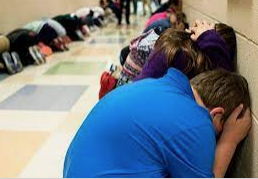By Jan Hillard
NKyTribune data editor
The recent tragic school shooting in Uvalde, Texas is a grim reminder of over 20 years of school shootings in the US.
In the 6 years from 2013 to 2019, there were 549 incidents of school shootings resulting in 129 deaths and 270 wounded, 208 of them children. This year alone has seen 27 school shootings. Each year more than 3,000 children are killed by gunfire. By any measure, this is the reality we have come to accept in the absence of effective gun control policy.
Ironically, there is no political topic more researched than gun control policy. The research demonstrates what works and what doesn’t. Yet in spite of these reports, our political leaders say they don’t know what to do, or they suggest solutions that are ineffectual, and in some cases, dangerous.

This article documents the scope of the school shooting disaster in the U.S., the strategies that can significantly reduce their frequency, and the ideas that have no evidence of success or pose a greater danger. Both categories of policies rear their heads after each school shooting. And the lack of political will rules the day.
Each day schools across the country face gun violence. And while most often this violence is not categorized as a mass shooting, where a shooter kills 4 or more, this gun violence brings with it trauma, suffering, and death to both students and teachers.
School-based shooting incidents include homicides, non-fatal assaults, unintentional gunshot wounds, self-harm and suicide, parking lot altercations, and gang violence. The frequency of these incidents not only compromises the safety of students, but it also impacts students’ learning and mental health.
The prevalence of gun violence experienced by our children is staggering. The FBI documents the following statistics: gun violence is the leading cause of death among children who are under 18, and 4 million children live in a home where there is at least one unlocked and loaded weapon. Since the Columbine shooting, 220,000 K-12 children have experienced a school shooting, while each year, 4 million students experience a school lockdown. Over time, both the federal and 42 state governments have taken steps to limit gun violence in schools and on school grounds (The Gun-Free School Zones Act of 1994). Laws defining schools as gun-free zones have lessened gun violence at schools, particularly student suicides and assisted homicides. Unconscionably, however, the gun lobby has sought to overturn these gun-free zone laws.
In an acknowledgment and grim acceptance that guns cannot be kept out of schools, children in 40 states are required to take part in active shooter drills. These drills, along with the “hardening” of school buildings and grounds, are the most common pro-active measures schools take to prevent gun violence. Not surprisingly, for-profit companies are the benefactors of these measures: they typically provide the drills accounting for a $3 billion safety industry that lacks evidence-based outcomes.
Yet, research-based evidence about active-shooter drills does exist. The nonprofit organization, Everytown Research, has thoroughly studied the evidence from years of school drills. Their article, “The Impact of Active Shooter Drills, 2021,” identifies mixed results associated with these drills.
To a degree, the drills do improve student compliance with emergency drills; however, typically students show difficulty maintaining silence, staying out of sight, and using their cell phones. In addition, drills can result in more profound and long-term issues. These include students who experience significant anxiety and fear immediately following a drill, obsession about villains they believe are lurking in the school, and suspicion of other students. These beliefs are exaggerated and proliferate via social media including posts that refer to killing and bloodshed.
In addition to research by Everytown, Georgia Tech’s Institute of Technology’s Social Dynamics and Wellbeing has conducted a large study of the immediate and long-term effects of drills on students. They find that active shooter drills are associated with increases in student depression, stress and anxiety, and psychological problems. These symptoms show up in children as young as 5-years old. Findings also indicate that active shooter drills impact teachers’ and parents’ mental health. These consequences of active shooter drills beg the question of the efficacy and necessity of the drills given their limited impact of recent school massacres. While the drills have some preventative value, they do not address the root causes of school shootings.

Photo from Edweek.org
Along with active shooter drills, some are calling for the arming of teachers. While on its face this may sound like a deterrent (e.g. stop a bad guy with a gun with a good guy with a gun), research by the Associated Press points to serious consequences with arming teachers. These include lack of initial and ongoing training and accidental shootings. Accidental shootings present the greatest concern: trained police across the country are associated with over 150 accidental shootings a year some resulting in death. These events occur when well-trained officers are flush with adrenaline, get surprised, or are out-gunned. According to the National Education Association, over 80% of all teachers reject the idea of being armed, citing student danger, accidental discharge, and limited effectiveness against well-armed shooters.
Everytown Research offers three evidence-based findings related to arming teachers. First, students will access teachers’ guns. Students discuss teachers’ guns among themselves and know where guns are kept. Teachers’ guns can be easily misplaced or stolen or taken by students. Second, the risk of shooting triples with access to guns. This includes accidental discharge and intentional shooting by actors such as disgruntled employees. Third, arming teachers introduces tremendous liability risks. Schools that propose arming teachers are uniformly denied liability coverage or indemnification. In addition, teachers may be exposed to criminal prosecution for accidentally discharging their weapon. Currently, only two states allow arming teachers. Other states and many more schools are considering this ineffective and dangerous solution.

Some groups, like the National Rifle Association and their affiliated elected officials, promote the idea that school shootings cannot be prevented. However, if you believe that school shootings should not be normal, there are evidence-based solutions that represent a comprehensive approach to school gun violence. The Giffords Center has clearly enumerated three solutions and the research behind them in their report, “The Truth About School Shootings, 2019.”
The Center points to child access prevention laws, extreme risk protection orders, and raising the minimum age for gun possession to 21 (from 2008-2018, 18–20 year-olds made up 36% of all active shooter incidents at schools) as the most effective policies designed to address the root cause of school gun violence.
The Giffords Center puts forth 5 myths that must be rejected if we are to impact the frequency and carnage of school shootings. These include:
Myth 1. School shootings are just a fact of life.
Myth 2. Nothing can be done to prevent school shootings.
Myth 3. Schools need to arm teachers.
Myth 4. School shootings are largely caused by the mentally ill.
Myth 5. Children are most likely to experience gun violence at schools.
After the recent massacre in Uvalde Texas, many Republican elected leaders, such as Senators Ted Cruz and Mitch McConnell, were astonishingly quick to mouth one of more of these myths. They have practiced these lines many times before. Doing so, asserts their allegiance to the gun lobby and assures continued monies from it.
This inaction from these senators and others to undertake any serious measures cannot continue.
Our children deserve better than this narrative, one that puts school children in danger every day.
Dr. Jan Hillard is data editor of the Northern Kentucky Tribune and retired Faculty Emeriti of Northern Kentucky University.




















